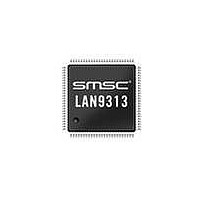LAN9313I-NZW SMSC, LAN9313I-NZW Datasheet - Page 91

LAN9313I-NZW
Manufacturer Part Number
LAN9313I-NZW
Description
Ethernet ICs Three Port 10/100 Ethernet Switch
Manufacturer
SMSC
Type
Three Port Managed Ethernet Switchr
Datasheet
1.LAN9313-NZW.pdf
(399 pages)
Specifications of LAN9313I-NZW
Ethernet Connection Type
10 Base-T, 100 Base-TX
Minimum Operating Temperature
0 C
Mounting Style
SMD/SMT
Product
Ethernet Switches
Number Of Transceivers
1
Standard Supported
802.3, 802.3u
Data Rate
10 Mbps, 100 Mbps
Supply Voltage (max)
3.3 V
Supply Voltage (min)
0 V
Supply Current (max)
155 mA, 270 mA
Maximum Operating Temperature
+ 70 C
Package / Case
TQFP-100
Lead Free Status / RoHS Status
Lead free / RoHS Compliant
Available stocks
Company
Part Number
Manufacturer
Quantity
Price
Company:
Part Number:
LAN9313I-NZW
Manufacturer:
Standard
Quantity:
261
Company:
Part Number:
LAN9313I-NZW
Manufacturer:
Microchip Technology
Quantity:
10 000
- Current page: 91 of 399
- Download datasheet (5Mb)
Three Port 10/100 Managed Ethernet Switch with MII
Datasheet
SMSC LAN9313/LAN9313i
7.2.3
7.2.3.1
7.2.3.2
7.2.4
7.2.4.1
7.2.4.2
10BASE-T Transmit
Data to be transmitted comes from the switch fabric MAC. The 10BASE-T transmitter receives 4-bit
nibbles from the internal MII at a rate of 2.5MHz and converts them to a 10Mbps serial data stream.
The data stream is then Manchester-encoded and sent to the analog transmitter, which drives a signal
onto the twisted pair via the external magnetics.
10BASE-T transmissions use the following blocks:
MII MAC Interface
For a transmission, the switch fabric MAC drives the transmit data to the PHYs MII MAC Interface.
The MII MAC Interface is described in detail in
Note: The PHY is connected to the switch fabric MAC via standard MII signals. Refer to the IEEE
10M TX Driver and PLL
The 4-bit wide data is sent to the 10M TX Driver block. The nibbles are converted to a 10Mbps serial
NRZI data stream. The 10M PLL locks onto the external clock or internal oscillator and produces a
20MHz clock. This is used to Manchester encode the NRZ data stream. When no data is being
transmitted (TXEN is low), the 10M TX Driver block outputs Normal Link Pulses (NLPs) to maintain
communications with the remote link partner. The manchester encoded data is sent to the analog
transmitter where it is shaped and filtered before being driven out as a differential signal across the
TXPx and TXNx outputs (where “x” is replaced with “1” for the Port 1 PHY, or “2” for the Port 2 PHY).
10BASE-T Receive
The 10BASE-T receiver gets the Manchester-encoded analog signal from the cable via the magnetics.
It recovers the receive clock from the signal and uses this clock to recover the NRZI data stream. This
10M serial data is converted to 4-bit data nibbles which are passed to the controller across the internal
MII at a rate of 2.5MHz.
10BASE-T reception uses the following blocks:
Filter and Squelch
The Manchester signal from the cable is fed into the PHY on inputs RXPx and RXNx (where “x” is
replaced with “1” for Port 1, or “2” for Port 2) via 1:1 ratio magnetics. It is first filtered to reduce any
out-of-band noise. It then passes through a SQUELCH circuit. The SQUELCH is a set of amplitude
and timing comparators that normally reject differential voltage levels below 300mV and detect and
recognize differential voltages above 585mV.
10M RX and PLL
The output of the SQUELCH goes to the 10M RX block where it is validated as Manchester encoded
data. The polarity of the signal is also checked. If the polarity is reversed (local RXP is connected to
RXN of the remote partner and vice versa), then this is identified and corrected. The reversed condition
is indicated by the flag “XPOL“, bit 4 in
MII MAC Interface (digital)
10M TX Driver (digital/analog)
10M PLL (analog)
Filter and SQUELCH (analog)
10M RX (digital/analog)
MII MAC Interface (digital)
10M PLL (analog)
802.3 specification for additional details.
DATASHEET
91
Port x PHY Special Control/Status Indication Register
Section 7.2.7, "MII MAC
Interface".
Revision 1.7 (06-29-10)
Related parts for LAN9313I-NZW
Image
Part Number
Description
Manufacturer
Datasheet
Request
R

Part Number:
Description:
Three Port 10/100 Managed Ethernet Switch with MII
Manufacturer:
SMSC [SMSC Corporation]
Datasheet:

Part Number:
Description:
Ethernet ICs Three Port 10/100 Ethernet Switch
Manufacturer:
SMSC
Datasheet:

Part Number:
Description:
Ethernet ICs Three Port 10/100 Ethernet Switch
Manufacturer:
SMSC
Datasheet:

Part Number:
Description:
FAST ETHERNET PHYSICAL LAYER DEVICE
Manufacturer:
SMSC Corporation
Datasheet:

Part Number:
Description:
357-036-542-201 CARDEDGE 36POS DL .156 BLK LOPRO
Manufacturer:
SMSC Corporation
Datasheet:

Part Number:
Description:
357-036-542-201 CARDEDGE 36POS DL .156 BLK LOPRO
Manufacturer:
SMSC Corporation
Datasheet:

Part Number:
Description:
357-036-542-201 CARDEDGE 36POS DL .156 BLK LOPRO
Manufacturer:
SMSC Corporation
Datasheet:

Part Number:
Description:
4-PORT USB2.0 HUB CONTROLLER
Manufacturer:
SMSC Corporation
Datasheet:

Part Number:
Description:
Manufacturer:
SMSC Corporation
Datasheet:

Part Number:
Description:
Manufacturer:
SMSC Corporation
Datasheet:

Part Number:
Description:
FDC37C672ENHANCED SUPER I/O CONTROLLER WITH FAST IR
Manufacturer:
SMSC Corporation
Datasheet:

Part Number:
Description:
COM90C66LJPARCNET Controller/Transceiver with AT Interface and On-Chip RAM
Manufacturer:
SMSC Corporation
Datasheet:

Part Number:
Description:
Manufacturer:
SMSC Corporation
Datasheet:

Part Number:
Description:
Manufacturer:
SMSC Corporation
Datasheet:











